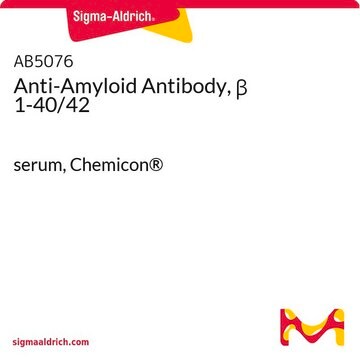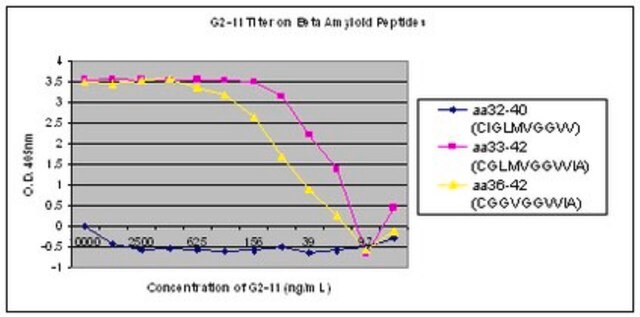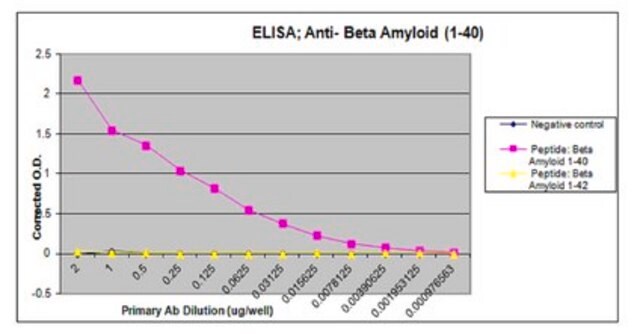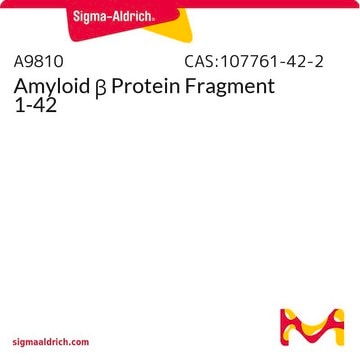The immunogen used to make this antibody corresponding to amino acids 1-40 of beta Amyloid. The antibody reacts specifically with β-amyloid protein. The epitope recognized by the antibody resides within amino acids 1-12 of the β-amyloid protein.
A5213
Anti-β-Amyloid antibody, Mouse monoclonal

clone BAM-10, ascites fluid
Synonim(y):
Anti-β-Amyloid antibody, Mouse monoclonal, Anti-A-BETA, Anti-Amyloid β Precursor Protein, Clone BAM91
Wybierz wielkość
3430,00 zł
Wybierz wielkość
About This Item
3430,00 zł
Polecane produkty
pochodzenie biologiczne
mouse
białko sprzężone
unconjugated
forma przeciwciała
ascites fluid
rodzaj przeciwciała
primary antibodies
klon
BAM-10, monoclonal
zawiera
15 mM sodium azide
reaktywność gatunkowa
human
rozszerzona walidacja
independent
Learn more about Antibody Enhanced Validation
metody
immunohistochemistry (formalin-fixed, paraffin-embedded sections): 1:2,000 using formic acid-treated, formalin-fixed, human Alzheimer′s disease (AD) brain sections.
indirect ELISA: suitable
izotyp
IgG1
Warunki transportu
dry ice
temp. przechowywania
−20°C
docelowa modyfikacja potranslacyjna
unmodified
Szukasz podobnych produktów? Odwiedź Przewodnik dotyczący porównywania produktów
Opis ogólny
Specyficzność
Immunogen
Zastosowanie
Działania biochem./fizjol.
Postać fizyczna
Przechowywanie i stabilność
Oświadczenie o zrzeczeniu się odpowiedzialności
Nie możesz znaleźć właściwego produktu?
Wypróbuj nasz Narzędzie selektora produktów.
produkt powiązany
Kod klasy składowania
10 - Combustible liquids
Klasa zagrożenia wodnego (WGK)
nwg
Temperatura zapłonu (°F)
Not applicable
Temperatura zapłonu (°C)
Not applicable
Wybierz jedną z najnowszych wersji:
Certyfikaty analizy (CoA)
Nie widzisz odpowiedniej wersji?
Jeśli potrzebujesz konkretnej wersji, możesz wyszukać konkretny certyfikat według numeru partii lub serii.
Masz już ten produkt?
Dokumenty związane z niedawno zakupionymi produktami zostały zamieszczone w Bibliotece dokumentów.
Klienci oglądali również te produkty
-
Please let us know the specificity of this antibody for Anti-beta Amyloid 1-40 or 1-41 or 1-42?
1 answer-
Helpful?
-
Active Filters
Nasz zespół naukowców ma doświadczenie we wszystkich obszarach badań, w tym w naukach przyrodniczych, materiałoznawstwie, syntezie chemicznej, chromatografii, analityce i wielu innych dziedzinach.
Skontaktuj się z zespołem ds. pomocy technicznej









